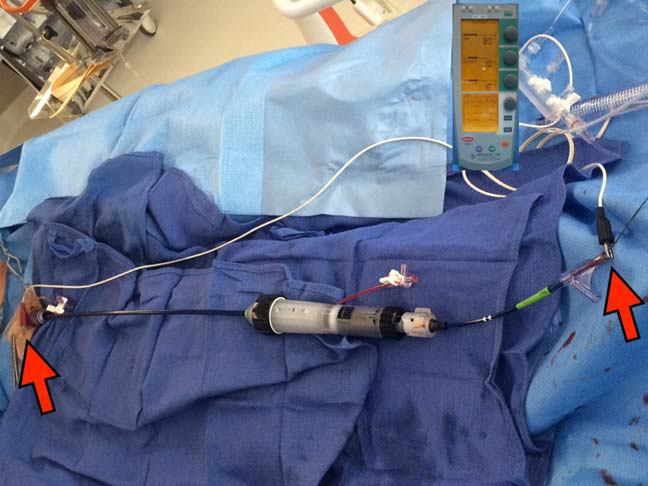
Right ventricular temporary pacing placed through venous access during aortic valvuloplasty or during TAVR is time-consuming and, above all, associated with cardiac perforation and tamponade.
Since both procedures require crossing the aortic valve and placing a left ventricular 0.035” guidewire, the latter can be used for rapid pacing, thus avoiding the need for right ventricular temporary pacing.
The cathode (negative pole) of an external temporary pacemaker is placed on the tip of the 0.035” wire and the anode (positive pole) is on a needle inserted into the groin. Insulation is provided by the very same valvuloplasty balloon catheter or valve release system.
This technique was used in 38 patients undergoing valvuloplasty and in 87 patients undergoing TAVR in three sites, with a 160-200 beats per minute pacing.
A significant drop in blood pressure up to a mean 44 mm Hg was achieved during rapid stimulation. Mean procedural time was 49.7 ± 31 min for valvuloplasty and 68.7 ± 30.9 min for TAVR. A temporary venous pacemaker was required in 12 patients and only 12% of TAVR patients had a femoral central venous catheter.
Femoral venous access was not performed in valvuloplasty patients. The only potentially related complication was one case of tamponade (0.8%) 8 hours after the procedure, successfully treated through subxiphoid puncture.
In-hospital mortality rates were 2.6% and 4.6% for the valvuloplasty and TAVR groups, respectively.
Conclusion
Use of the 0.035” guidewire for rapid pacing during valvuloplasty or TAVR was shown to be simple and reproducible. It prevented complications associated with a right ventricular temporary pacing catheter. In consequence, this technique can simplify and enhance the safety of transcatheter aortic valve replacement.
Original title: Rapid Pacing Using the Left Ventricular Guidewire: Reviving an Old Technique to Simplify BAV and TAVI Procedures.
Reference: Benjamin Faurie et al. Catheter Cardiovasc Interv. 2016 Nov 15;88(6):988-993.
Subscribe to our weekly newsletter
Get the latest scientific articles on interventional cardiology
We are interested in your opinion. Please, leave your comments, thoughts, questions, etc., below. They will be most welcome.






